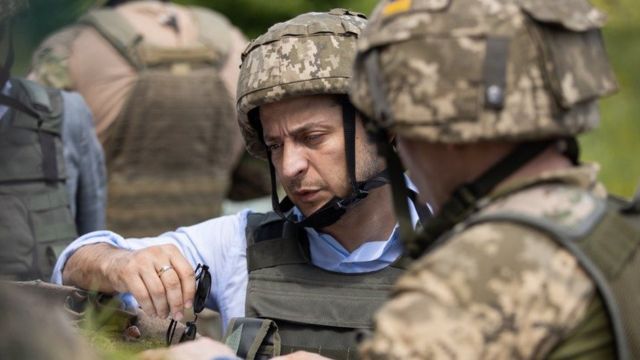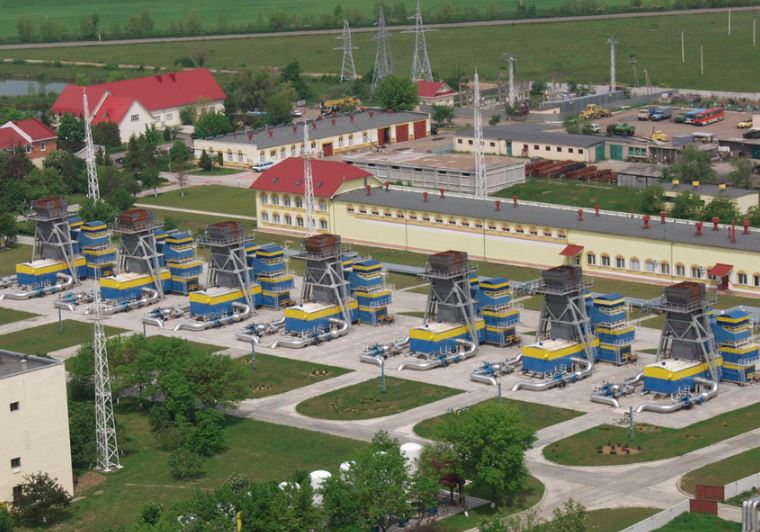The real or imaginary threat
President Zelenskyy has repeatedly reiterated his electoral promise to end the war. The president is, of course, talking about “the war in Donbas.”
In contrast, his predecessor stressed that Ukraine was exposed to a Russian Hybrid War, often warning about the risk of a full-scale Russian invasion and underlining that Russia would remain a threat to Ukraine for decades. His threat assessment at the time was in line with the National Security Strategy and Military Doctrine of Ukraine, developed with inputs from the Ukrainian Armed Forces, Foreign Intelligence Services, Defense Intelligence of Ukraine, Security Service of Ukraine, Law Enforcement structure, and international partners.
[highlight]The term “Hybrid War,” “invasion,” or “threat” (to Ukraine) is hardly used by President Zelenskyy.[/highlight] Ironically, one of the few times the President used the term “Hybrid War” was when he introduced the new Head of the Foreign Intelligence Service of Ukraine (FIS), Valeriy Kondratiuk.The head of FIS, however, embraces the term.
He recently outlined the main threats Ukraine is facing as a “hybrid war, an armed conflict, Russia’s aggressive policy towards internal socio-economic and political processes in Ukraine, attempts by Kremlin authorities to undermine support for our state at the international level.”
It is a great analysis and should be read by anyone involved in security and defense policy, conflict resolution or simply, concerned about the future sovereignty and independence of Ukraine. It is very much in line with my attempt to conceptualize the Hybrid War.
The article is, however, also important because it demonstrates a fundamental gap between the threat assessment of the Supreme Commander-in-Chief of the Armed Forces of Ukraine and his intelligence services.
The conceptual differences between President Zelenskyy’s “war in Donbas” and the Hybrid War presented by the head of FIS are staggering. The means employed are hugely different. As are the scope, time and space.
“War in Donbas”
If you enter the search term “threat to Ukraine,” “invasion,” or “Hybrid War” on the website of the President of Ukraine you will find that the terms are hardly used anymore. All news, statements and assessments to the effect by former President Poroshenko were deleted from the official website of the President of Ukraine immediately after Zelenskyy took office.
In stark contrast to the Security Strategy and Military Doctrine developed in 2015, President Zelenskyy’s strategic communication focuses on the military aggression in Donbas.
His security and defense policy, his international engagement and reform agenda revert around the one-dimensional military threat in Donbas, not the overreaching and fundamental threat the Russian Hybrid War pose to the Ukrainian statehood.
As a consequence, the Minsk agreements (Minsk Protocol of 5 September 2014, Minsk Memorandum of 19 September 2014, and Minsk Set of Measures of 12 February 2015) continue to serve as the basis for the diplomatic effort to achieve a peaceful resolution of hostilities. The agreements further reinforce the impression that the ongoing Russian aggressions are limited to Donbas only.
Time
Officially, Russian hostilities started 20 February 2014. The “war in Donbas” began nearly two months later (14 April 2014). Seen through the prism of “war in Donbas” the war is, therefore, in its seventh year.
The number of violations since 27 July, the start of the more than 20th Cease Fire Agreement, have been exceptionally low. While the average monthly number of OSCE/SMM reported ceasefire violations for the last 5 years has been 26678 (2016), 33445 (2017), 25442 (2018), 24869 (2019) and 20648 (2020, until and including July) respectively, the number of violations fell to the unprecedented level of 605 in August.

As a consequence of what Maria Zolkina calls an “illusory regime of silence,” President Zelensky has expressed hope to end the war already this year (and no later than by the 30th anniversary of Ukraine’s independence.
Space
The “war” takes place in certain areas of Donetsk and Luhansk oblasts, an area of 16 799 km². The area constitutes a mere 2,8% of the Ukrainian territory.

The international diplomatic peace efforts are limited to this geographic area only. Presently, there is no international platform in place to alleviate the Russian illegal occupation and control of other areas.
Scope
It is often described as a conventional war involving warfighting between Ukrainian and Russian regular and proxy land forces. The term “frozen conflict” is increasingly more often being used.
The Hybrid War
Time, space and scope of the Hybrid War are profoundly different from the “war in Donbas.”
Time
The Hybrid War did not start in 2014. The first out of five phases (shaping) started decade(s) ago. It involved the dismantling of the Ukrainian Security and Defense Sector, the shaping of the information domain, preparation of the economic and political space, and more. The second (and active) phase of the Hybrid War started 20 February 2014.
The last three phases (crisis, resolution, and restoration of peace) lays still in the future.
This knowledge is crucial. While the ongoing peace initiatives try to fix a crisis that is perceived to have happened, the “game-changing” crisis has yet to take place.
Space
[highlight]Russia is not fighting for Donbas but all of Ukraine. [/highlight]While its military means until now have only been employed in Eastern Ukraine, Sea of Azov, Crimea and the Black Sea, Russia is actively employing its non-military tools across all of Ukraine.By contrast, the “war in Donbas” and the Minsk agreements only cover a mere 2.8% of the Ukrainian territory. Even worse, this only constitutes 11.6% of the area that is de facto illegally occupied or controlled by Russia.

Russia is controlling approximately 19.6% (145 000 km2) of Ukrainian territory and areas under its jurisdiction. This includes Ukraine’s Autonomous Republic of Crimea, the city of Sevastopol, the adjacent Maritime Exclusive Economic Zones, and certain areas of Donetsk and Luhansk oblasts.
Additionally, the frontlines are hugely dissimilar. Whereas the frontline separating the military forces are 420 km long and run through Donbas, the frontline of the Hybrid War runs along its western Ukrainian borders.

Scope
The head of FIS highlights Russia’s Hybrid War, and its parallel and synchronized use of both military and non-military means. Russia ongoing aggressions include a long list of aggressions against Ukraine. While not complete, it still includes:
- the illegal annexation, as well as continuous militarization and humanitarian violations in Crimea;
- the armed conflict in eastern Ukraine and the creation of new permanent military formations along the Ukrainian border;
- the downing of MH-17,
- the maritime blockade in the Sea of Azov and attack on the Ukrainian Navy;
- the ongoing attempt to destabilize Ukraine from within using non-military means.
The non-military means alone encompasses the use of diplomatic, political, energy, economic, informational, religious, legal, and security instruments. These have evolved and includes today both external and internal threats.

In his excellent analysis, Valeriy Kondratiuk outlines some of the internal threats (e.g. “fifth column,” pro-Russian TV channels in Ukraine and threats emerging on religious grounds). The “internal factor” is increasingly reflected in the political landscape, illustrating the dynamics of the Hybrid War. Already in May 2018, the Ukrainian journalist Serhiy Hrabovskyi warned that “a “hybrid war” is being waged against Ukraine using the “fifth column” and the elections in 2019 would “shake Ukraine so much that the concrete consequences of this may be not only dramatic but also tragic.”
The pro-Russian forces in Ukraine have become both bolder and more omnipresent during the last couple of years. A high number of Ukrainian politicians are openly supporting Russia or the agenda of pro-Russian (anti-reform) oligarchs. Representatives of the “old guard” are increasingly taking up positions at the cost of reformists and pro-western forces. Reformists, activists and journalists are more and more being targeted and we see clear signs of revanchism. Russia and its supporters are bit by bit taking control of the Ukrainian media and consequently, the main battlespace. The anti-Western narrative is gaining traction. As late as in late July the Ukrainian journalist Liubov Velychko revealed how several pro-Russian Telegram channels influence both the parliament and the media. According to Tetiana Shevchuk, pro-Kremlin parliamentarians and oligarchs are waging lawfare on Ukraine’s reform agenda in an attempt “to derail Ukraine’s westwards momentum and return the country to the Russian sphere of influence.” The independence of several key institutions is being threatened.
The internal threat is, if not as bluntly, still broadly outlined by the European Court of Auditors. It has listed a low level of compliance with the rule of law and an exceedingly high level of corruption as its major problems, alongside that of poverty and war:
“Ukraine suffers from grand corruption and the influence of an oligarchy, which severely hinder its economic development. The stranglehold of the country’s oligarchy extends to the judiciary and government, hampering any democratic development.”
If the proverb “the enemy of my enemy is my friend” is still valid, anyone opposing the Ukrainian reform process and westerly trajectory are friends of Russia. The head of FIS called them the fifth column.
The difference in scope, however, goes beyond the use of non-military means. Even the military part of the ongoing Russian Hybrid War in vastly different from the “war in Donbas.”
The maritime part of the Hybrid War has been a crucial element of the conflict since the very start of the active phase of the Hybrid War. Ukraine lost most of its Navy in 2014. The maritime threat has continued to evolve during the last six years and includes the capture of Ukrainian drilling rigs which was later equipped with surveillance systems, illegal gas extraction, the opening of Kerch Bridge, the maritime “blockade” of Ukrainian ports in the Sea of Azov and the attack on and detention of 3 Ukrainian warships. Additionally, Russia has taken an increasingly more aggressive posture towards NATO units operating in the Black Sea and at times, imposed huge restrictions on Freedom of Navigation in the Black Sea.
It is noteworthy that the restrictions to commercial shipping through the Kerch Strait are again increasing as the last in a series or “comprehensive, sustainable and unlimited ceasefire” agreement entered into force.
Additionally, the Minsk Protocol does not regulate Russia’s militarization of Crimea or its increased military posturing along the Ukrainian borders. Russia has “created three combined arms forces which are capable of carrying out sudden limited-objective offensive operations on the territory of Ukraine without mobilization and with minimal preparation.” They are expected to be fully operational in 2020-2021.
According to the report, the personnel strength of the Russian ground force along the Ukrainian border is estimated at 87,000 military men, up to 1,100 tanks, up to 2,600 armored combat vehicles, up to 1,100 artillery systems, up to 360 multiple launch rocket systems, 18 SRBMs. The navy consists of nearly 70 warships and boats, 6 submarines, capable of a joint salvo of 84 Kalibr cruise missiles. Additionally, about 330 combat aircraft and 230 helicopters have been redeployed to base airfields near the border. These numbers will increase shortly as a result of the Russian decision to relocate the 47th Mixed Air Regiment (Su-34 bombers) to Voronezh, close to Ukraine’s borders.
The evolving situation in Belarus might potentially, further aggravate the security situation. As Bohdan Nahaylo pointedly argues, Russia might “be in a position to significantly increase the encirclement of Ukraine.”
So what?
The Russian Hybrid Forces (1st and 2nd Army Corps) and regular forces occupying parts of Ukraine (Donbas and Crimea) are a part of the threat that the Russian forces presently stationed along the borders of Ukraine constitute. These forces, however, are also only a part of the combined arms at the disposal of the Western and Southern Military District of Russia. The military threat to Ukraine is immensely broader than what is directly involved in the “war in Donbas.”
But even more important, the Russian Armed Forces are only one out of the many tools put to use to, in the words of Valeriy Kondratiuk, bring Ukraine back into the orbit of total influence, eliminate its national identity and independence, establish external control over the ongoing processes in the country, and ultimately terminate Ukraine as a sovereign state. The Hybrid War includes the parallel and synchronized use of both military and non-military means, where the latter encompass the use of diplomatic, political, energy, economic, informational, religious, legal, and security instruments. These have evolved and involves today both external and internal pro-Russian forces.
The Hybrid War involves all of Ukraine and every single Ukrainian citizen. It takes place both across the land and sea territory of Ukraine, as well as the maritime area under Ukrainian jurisdiction. The front line is not in Donbas, but along the western Ukrainian borders.
The international community’s single-minded focus on the Minsk Agreements does not help. It means that both Ukraine and the West avoids tackling the core challenge of the Hybrid War. It leaves Russia free to continue its efforts to destabilize Ukraine from within using Political and Economic Warfare, Cyber Warfare, Criminality, Corruption, Influence Operations, Lawfare, and more.
The Hybrid War and the attempt to destabilize Ukraine has been ongoing nonstop for more than six years already. It is a highly dynamic process. And it works.
Failing to understand the full scope of the Hybrid War and thereby lacking a common conceptual understanding, increases the risk of us choosing the wrong counter-strategy. Even more crucially, it leaves us ill-prepared for the real crisis to come.
These following questions are therefore crucial:
- Why does President Zelenskyy only talk about the “war in Donbas” when his intelligence services describe a fundamentally different (Hybrid) War?
- Why have all references to President Poroshenko, including previous threat assessments, been deleted from the official website of the President of Ukraine?
- Why is the President insisting on negotiating a peace agreement that does not address Russia’s overall aim and objective; namely “termination of Ukraine as a sovereign state”?
- Why does Zelenskyy want to pass the bill on nationwide referendum in the middle of a Hybrid War and an ongoing influence operation, in which the main battlespace is the mind and the “cognitive spaces of both populations and key decision- and policymakers?
Read also:
- Leaked Kremlin emails show Minsk protocol designed as path to Ukraine’s capitulation – Euromaidan Press report
- Telegram: the Russian messaging app at the heart of a major influence operation in Ukraine
- The basis for a peaceful resolution of the war in eastern Ukraine – trends at the end of 2019
- Minsk protocol and “Steinmeier’s formula” – conflict resolution or conflict conclusion?
- Urging to reconsider Russia sanctions: peace at the cost of European integrity
- What if? Hybrid War and consequences for Europe (part 1)
- What if Russia wins in Ukraine? Consequences of Hybrid War for Europe (Part 2)






